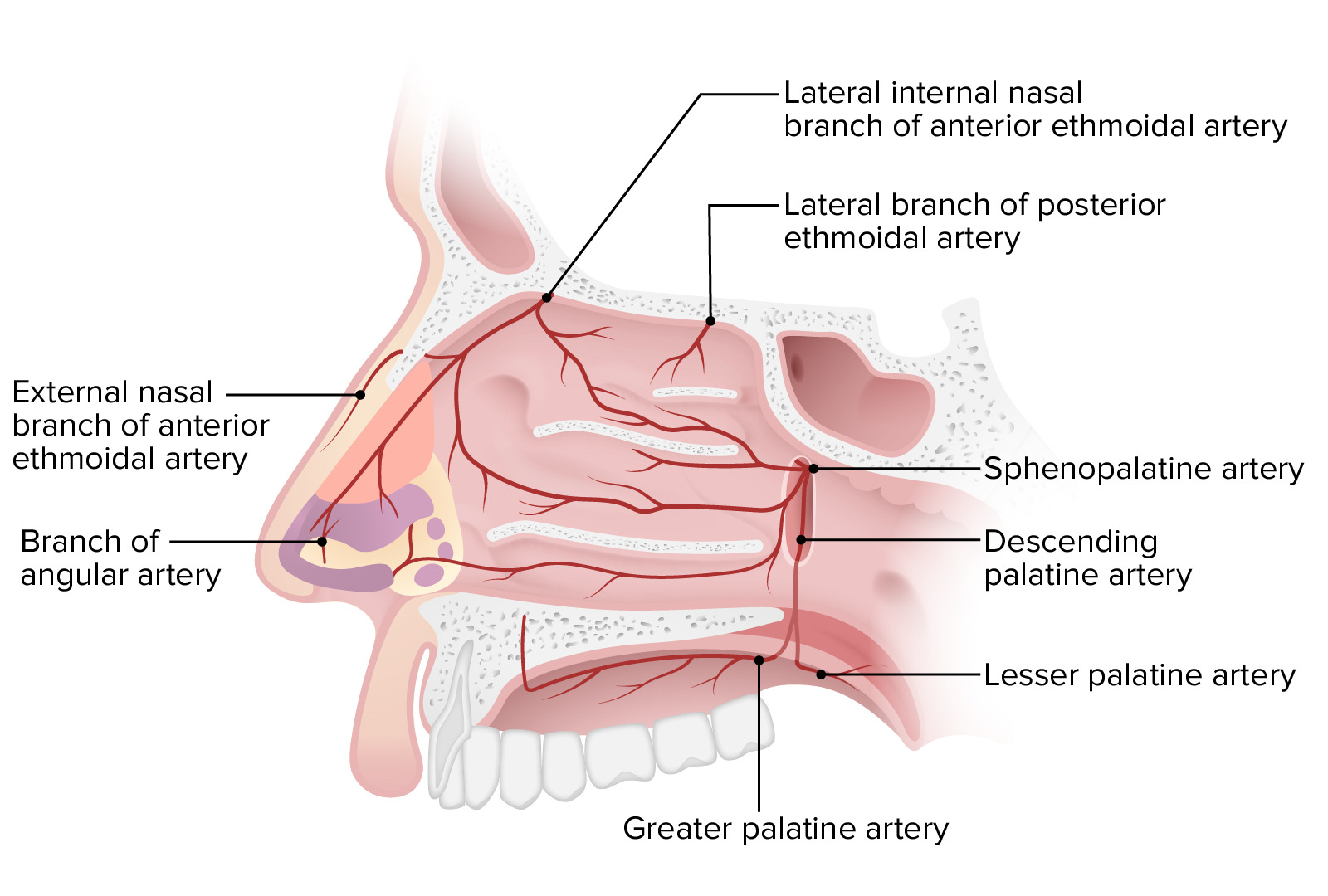Playlist
Show Playlist
Hide Playlist
External Nose, Cartilaginous Structures, and Nasal Cavities
-
Slides Anatomy Nose.pdf
-
Download Lecture Overview
00:02 All right, this presentation is on the anatomy of the nose. 00:08 And here, we're going to begin with the external nose and we'll look at the relative regions that contribute to the external nose. 00:18 The first area, is shown in through here and over in through here, in the view to the right. 00:25 This area represents the “Root” of the nose and it's located between the eyebrows. 00:31 Just inferior to the root of the nose, you have the "Bridge" of the nose, it's better kind of seeing in through here. 00:38 You can see how the bridge is depressed below the root of the nose and then from here, the nose will slope, have an inclination and the sloping portion of the nose, that we better see here in the figure to the right, is going to be the “Dorsum nasi.” The lateral flares of the of the nose are each one is an “Ala.” And then on the inferior aspect, if you travel down the dorsum nasi, and come right in through here around the corner, you have this inferior projection of the external nose, called the “Apex.” And then inferior to the apex associated with the upper lip, is a continuation of the “Philtrum.” The nose is made up of skeletal features or structures, as well as cartilaginous structures, so, we'll take a look at the cartilaginous structures. 01:39 Here we see a collection of cartilaginous structures, of the external nose. 01:45 We'll look at the bony framework around the nose, superiorly here is the “Frontal bone.” Here's the skeletal feature, forming the external nose, called the nasal bones paired. 02:00 We also have the “Maxillary bone,” shown in through here and also appearing in this view is, one of the first cartilaginous structures of the external nose, it lies, just inferior to the nasal bones. 02:14 And this is the lateral process of the septal nasal cartilage. 02:18 The lateral process of the septal nasal cartilage, is triangular in shape, the upper part does fuse, with the septal cartilage, that we'll see in a subsequent slide. 02:30 But for now, the superior margin of this cartilage, shown along in through here, is attached to the nasal bone and then the frontal process, of the maxillary bone, which is right along and through here. 02:44 The inferior margin right along and through here, is connected by fibrous tissue, to the lateral crus of the major alar cartilage and that is the major alar cartilage, right in through here. 02:57 And then laterally it is attached indirectly to the margins of the piriform aperture, by loose fibro aurelia connective tissue and this tissue may also contain one or more small sesamoid cartilages and we do have a sesamoid cartilage, right in through here. 03:18 This slide is showing the major alar cartilage, that was referenced, in the previous slide, you see it again labeled right in through there for you. 03:30 Medially the major alar cartilage attaches, to the contralateral counterpart. 03:38 So, right and left right here in the midline, and then to the antero inferior part of the septal cartilage. 03:45 Laterally, it is connected to the frontal process of the maxilla, which will be right along in through here and in addition to the lateral crus of the major alar cartilage, we also have the medial crus of the alar cartilage, right into here. 04:04 This is showing the septal nasal cartilage. 04:08 You just see a little bit right in through here, the next slide will show us, the septal cartilage in this particular view. 04:19 It is quadrilateral in shape, the antero superior margin is connected above to the posterior border, of the inner nasal suture, so, the nasal bones are right in through here and where those right left nasal bones meet there's a suture and that would be the anterior superior margin. 04:43 The anteroinferior portion the cartilaginous septum, is attached to the anterior nasal spine, which is, a projection of the maxilla. 04:53 And then the postero superior border joins the perpendicular plate, of the ethmoid bone. 05:02 This would be the postero superior border and this would be the perpendicular plate of the ethmoid bone. 05:11 This particular view, shows the septal cartilage, dividing the nasal apertures right and left. 05:22 Here's an internal view, demonstrating the nasal cavities. 05:27 We start unlabeled, but let's take a look at what we have here. 05:32 The nasal cavities are separated into right and left ones, by the septum and we see the nasal septum highlighted right in through here. 05:43 This bony feature, is called the, “Middle concha,” it is a part of the ethmoid bone. 05:51 So, it projects into the nasal cavity on the right side as well as the left side. 05:59 We also have in this particular view, another concha, this is the “Inferior concha,” these are paired as well, these are individual bones. 06:12 And then, not a bony feature, but if you look around, on the lateral aspect of the inferior concha, you have is known as a “Meatus.” And since this meatus is associated with the inferior concha, it is called the, “Inferior meatus.” And then outside of the nasal cavities, but in communication with the nasal cavities are, “Sinuses.” And this particular sinus is the, “Maxillary sinus” and it is bilateral, so we see the right one in the left one. 06:47 And more to come on drainage into the nasal cavity, a little bit later.
About the Lecture
The lecture External Nose, Cartilaginous Structures, and Nasal Cavities by Craig Canby, PhD is from the course Head and Neck Anatomy with Dr. Canby.
Included Quiz Questions
Which structure is just inferior to the bridge of the nose?
- Dorsum nasi
- Root
- Philtrum
- Ala
- Apex
What is the shape of the lateral process of the septal nasal cartilage?
- Triangular
- Rectangular
- Octagonal
- Circular
- Linear
Which structure is lateral to the inferior concha?
- Inferior meatus
- Middle concha
- Superior concha
- Apical concha
- Nasal cavity
Customer reviews
5,0 of 5 stars
| 5 Stars |
|
5 |
| 4 Stars |
|
0 |
| 3 Stars |
|
0 |
| 2 Stars |
|
0 |
| 1 Star |
|
0 |




